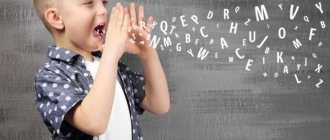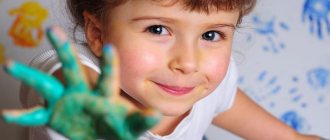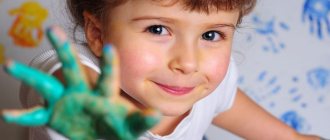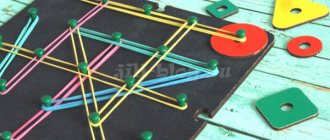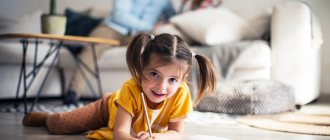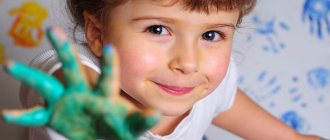When a child turns 3 years old, both parents and the baby themselves face tremendous changes. This is the famous crisis of three years, and a possible acquaintance with kindergarten, and for the first time truly meaningful behavior.
The pace of development of children is individual. Some three-year-olds already speak fluently, show interest in learning and strive for complete independence. Other children at the same age do not develop as actively, but this is not a deviation at all. However, there are general standards for what a 3-year-old child should be able to do. And if you are worried about whether your baby is developing in a timely manner, follow these standards and, most likely, you will make sure that everything is fine with your child!
Content:
- Basic skills of a child at 3 years old
- Physical development: main indicators Height and weight
- Physical skills
- Motor skills
Logical thinking
At 3 years old, children already have some logical thinking skills. They must be able to:
- combine two objects into a logical pair (“pencil-paper”, “tea-cup”);
- exclude unnecessary items from a group;
- understand the logical sequence of events (clouds gathered in the sky - it began to rain - the ground became wet);
- highlight the main properties of objects and combine them into groups according to these properties;
- understand time sequence (“yesterday”, “today”, “tomorrow”, “now”, “later”);
- distinguish opposites (big - small);
- understand the location of objects in space (“above”, “below”, “above”, “below”).
Basic skills of a child at 3 years old
What a child should be able to do at the age of three - basic standards:
- understand simple cause-and-effect relationships, for example, “fell in a puddle - got dirty”;
- begin to strive for independence: try to dress yourself or with minimal help from an adult;
- actively expand your vocabulary, use complex sentences in speech, for example: “We didn’t go for a walk because it was raining outside”;
- know the basic colors and the words that these colors represent;
- recognize obstacles in the area - for example, steps, curbs - and overcome them;
- be able to show emotions and control emotions, show empathy;
- understand the meaning of the words “mine” or “his/her”
- play role-playing games - for example, “teacher-student”, “doctor-patient”.
Features of the development of speech and social skills at 3.5 years
Exercise option for the development of a 3.5 year old child.
At 3.5 years old, a child can already:
- count to 10 and back;
- navigate concepts such as “many”, “little”, “high”, “long”, etc.;
- know the names of primary colors and shades;
- find differences between two pictures and explain what the discrepancy is;
- compare similar items;
- find an extra one in a group of objects, justifying your decision;
- remember sequences of words and phrases;
- clearly explain the difference between a city and a village, a tree and a bush, etc.;
- navigate the types of plants, talk about the characteristics of the most common shrubs, flowers, trees in your native region;
- describe natural phenomena;
- explain, by feeling the object, what it is made of, what shape it has;
- tell the difference between day and night, autumn and winter, etc.
The main attention should be paid to the child’s speech development. Already at 4 years old you can start learning letters and syllables.
Physical development: main indicators
The physical development of a child is assessed according to three main criteria: height and weight, physical abilities, and motor skills.
Height and weight
The height and weight of two children at the age of three can differ significantly - these physical parameters depend on hereditary factors and, to a lesser extent, on the child's gender and lifestyle. In pediatrics, the “golden mean” for the weight of a three-year-old is considered to be 15 kilograms, for height - 95 centimeters .
If your baby’s height is 10% less than the standard 95 centimeters, this is not a cause for concern, but, most likely, a personal developmental feature. But if your son or daughter’s height at 3 years is less than 85 centimeters, you should think about eliminating negative factors: try to adjust the baby’s diet and organize reasonable physical activity for the child, after consulting with a doctor.
In the weight parameters for a three-year-old child, deviations of 20% are allowed in both directions from 15 kilograms. If the baby’s weight is less than 12 or more than 18 kilograms, you may need to reconsider the diet, taking into account the recommendations of pediatricians.
Physical skills
Basic physical skills of a three-year-old:
- knows the terrain well enough, remembers familiar routes;
- draws and makes simple appliqués himself;
- knows how to ride a tricycle:
- claps his hands and stomps his feet well;
- With the help of his parents, he assembles quite complex construction sets, and also puts together multi-part puzzles with outside help.
Motor skills
By the age of three, the child’s motor activity develops noticeably even compared to the period of several months preceding the third birthday. Basic motor skills of a child at three years old:
- maintains balance while standing on one leg;
- climbs and descends stairs without assistance;
- plays various ball games;
- runs, rarely stumbling and falling;
- repeats simple dance movements: jumps, rises on tiptoes.
Nuances of the psyche of three-year-old children
The developmental characteristics of 3.5-year-old children indicate big changes in their emotions. Children develop a sense of self-esteem, they are proud of themselves that they can do something better than anyone (jump, play), that they have the best parents: the smartest dad, the kindest mother. They develop an understanding of humor; cartoons or comical life situations make them laugh. Kids notice beauty and ugliness in nature and in life and can appreciate it.
A child can react emotionally in different situations:
- empathy if someone nearby is feeling bad or in pain;
- help, if he can do it;
- responsiveness: if the parents are tired, he will not interfere with their rest;
- sympathy for the heroes of fairy tales and cartoons: he can be happy, sad, angry with them;
- understanding that he acted badly makes him sad and ashamed;
- experience in anticipation of a negative assessment or censure from adults.
A child can harbor a grudge for a long time if he is punished. But he sees when someone else acts badly and evaluates such an act negatively: you can’t do that. Sometimes you may encounter exaggerated feelings of jealousy or resentment. And there is no need to teach him pretense and cunning, pranks and pranks. A sense of caution is being formed, a distinction is made between the concepts of danger - safety, harm - benefit, anxiety and fear of the dark may often appear. A three-year-old child can complete verbal three- or four-step instruction. The child’s compliance increases, he begins to realize the possibility of delaying the immediate fulfillment of his desires. With the right parenting, three-year-olds can hold back emotionally.
Development of fine motor skills
The fine motor skills of a three-year-old are becoming more and more perfect. The child develops previous skills and acquires new ones:
- enjoys repeating finger gymnastics exercises;
- reinforces speech with gestures, and if the baby is emotional, gestures can be very active;
- builds buildings of different sizes and configurations from cubes;
- learns to use scissors and can cut out simple shapes from paper;
- knows how to sculpt simple structures from plasticine: flagella, balls;
- confidently grasps and holds objects;
- opens loose caps on bottles.
Development of attention
Three-year-olds must have the following skills:
- concentrate on the task at hand for 10–15 minutes;
- keep up to five objects in your field of vision at the same time;
- remember and repeat after an adult the suggested words and movements.
It is worth remembering that the attention of a junior schoolchild is still unstable and easily scattered.
Development of hearing, vision, touch, taste
The hearing of three-year-old children requires especially careful attention. At this age, children often catch colds, which can lead to otitis media and, as a consequence, hearing impairment.
In order not to harm your child’s hearing, be sure to teach him to breathe through his nose and not his mouth, treat a runny nose in a timely manner and try to avoid sudden changes in temperature.
The vision of three-year-old children is not yet sharp enough compared to children of older preschool age. Vision is fully formed only by 6-7 years. You should not try to teach your child to read as early as possible - children's vision is ready for reading only at the age of five . Of course, you can show books to a three-year-old, but the books must use large font. To preserve fragile children's vision, reduce your child's contact with the phone, computer, and TV.
At 3 years old, children’s sense of touch is well developed: they distinguish between cold and hot water, warm and cold wind, rough and smooth surfaces. The taste buds of a three-year-old child are developed in the same way as those of an adult. It distinguishes between sweet, bitter, sour and salty tastes, preferring sweets.
Intellectual development
At this age, visual-effective thinking is transformed into visual-figurative thinking. If previously the baby learned about the world through direct contact with various objects, now he can already operate with images of these objects stored in his memory.
At three years old, a child should be able to:
- understand simple cause-and-effect relationships;
- demonstrate first action planning skills;
- compare objects by size, shape, color;
- put together simple puzzles from four large parts;
- know the basic colors and be able to name them;
- know the names of surrounding objects (dishes, furniture, products), animals;
- know the names of basic geometric shapes.
An important feature of this age is that a growing baby can think and reason about objects that are not in the field of view. This is an important step towards further development of thinking.
Norms of speech development
A three-year-old child already has a fairly rich vocabulary: at least 1000 words. The clarity of speech at this age is not yet impeccable: the baby may distort words and have difficulty pronouncing individual sounds correctly. A three-year-old is already able to reason in a simple form about an object or event he saw.
A 3-year-old child does not speak or speaks little: what to do?
At three years old, a child’s speech skills are sufficiently developed to be able to communicate with other people. Normally, by the age of three years, a child has the following speech skills:
- understands the questions asked and answers them;
- knows his first and last name well;
- speech becomes coherent, resembling a story: one sentence follows from another;
- describes the picture he saw, paying attention to details;
- retells short tales and stories.
Children who speak almost or not at all by the age of three are quite common. The famous Russian pediatrician Evgeniy Komarovsky advises parents whose children at 3 years of age do not yet speak to pay attention to the type of stubborn silence: is the child silent because he does not understand the speech of those around him, or does the baby understand everything, but says nothing?
If a child shows signs of understanding without using words, perhaps silence is his personal trait. Three-year-old silent children, according to pediatrician statistics, are more common among boys—for every one non-talking girl, there are four such boys. According to the same statistics, at least 7% of children aged three years do not speak at all.
In any case, if a three-year-old child does not speak at all, you need to visit a pediatrician with him. Based on the examination results, the doctor will recommend ways to solve the problem or refer you to specialized specialists.
Features of the psychological development of a baby in the fourth year of life
Children in the third year of life strive to understand everything that surrounds them, and are happy to study what their parents offer them. In moments of crisis, when a child throws groundless tantrums, you should talk to him calmly, gently seeking understanding on his part and overcoming psychological discomfort.
Over the course of 3.5 years of life, the child has already learned well to detect any changes in the home atmosphere and the behavior of the people around him, so it is worth talking more often about love for him and his significance. With affection shown by parents, children become more balanced.
A child at this age can already concentrate on one task for 20 minutes. It is best to alternate different types of activities so that interest in tasks and games does not disappear.
Parents should pay attention to improving their children's speech and social skills. Psychologically, they are already developed enough to understand what friendship is and what it is built on, and how to resolve conflicts that arise. Through short conversations on topics about the feelings of other people, you need to teach the child not only to assess the situation from his own position, but also to look at what is happening from different angles.
Communication skills and emotional sphere
A three-year-old child needs to communicate with peers more than before. The child is already learning to manage emotions and trying to resolve conflicts peacefully. At the same time, the three-year-old feels an urgent need to express his “I”, which leads to capricious behavior towards parents and other close people. Closer to four years, the child begins to understand other people's emotions, learns to control himself and excessive whims disappear.
The emotional sphere of three-year-old children is actively developing: they begin to fantasize. The guys with the richest imagination even surprise others with stories of their own creation. Normally, an emotionally developed child at 3 years old strives to repeat the actions he likes after other people, and knows how to express likes and dislikes.
The world
At three years old, children already have certain knowledge about the world around them. They distinguish between wild and domestic animals, know the names of some trees, flowers and other plants. Kids also know the names of vegetables and fruits and imagine where they grow (in the garden, in the forest).
Three-year-olds should already know the seasons and days and their sequence, the names of the days of the week and months. Also, kids must remember their first and last name, the names of family members, and the name of the city.
Children must be taught basic safety rules (not to go outside without their elders, not to run out onto the road, not to touch medications, sharp, hot objects, not to turn on appliances).
Mental development
Along with the crisis of three years comes the age of “why”. The child asks adults about everything in the world, compares the answers, and draws conclusions.
The pace of mental development in different children may differ depending on the child’s personal abilities and the involvement of adults in the development process. Intellectual development at the age of three is considered normal if the child can:
- distinguish 4-8 colors;
- examine the object not only as a whole, but also notice details;
- do not be distracted too often, concentrate on one activity;
- make simple plans, for example: “in the morning we will go to kindergarten, and in the evening you will take me home”;
- count to five;
- find answers to children's riddles;
- operate with the concepts of “more-less” and find other differences between objects;
- memorize simple poems and songs;
- distinguish basic geometric shapes from each other - circle, triangle, rectangle, square - and name them.
Neuropsychic development
During this period, the performance of the nervous system increases. The baby can already restrain his emotions, for example, not cry when he is hurt or offended.
His ability to concentrate increases. Now he can do something for 10–15 minutes without being distracted by anything else. Distracting a crying three-year-old by redirecting his attention is not so easy, because he has already concentrated on his negative emotions.
At this age, the child cannot yet properly manage his behavior. The three-year crisis mentioned above also adds to the difficulties. The baby's inner world is full of contradictions that result in whims and hysterics.
Cognitive development
Children's cognitive skills include the development of perception, attention, memory, and thinking. The speed of cognitive development is influenced by the child’s exploration of the world around him: the more the baby interacts with different objects and the more he observes different phenomena, the better his cognitive abilities develop.
It is important for three-year-old children to experience the world in practice, which is why it is so important to reinforce the child’s personal experience with explanations from an adult. For example, explain the difference between opposing concepts (“narrow path - wide road”), encourage the child’s desire to analyze situations and events, and focus on specific details of objects.
At the age of three years, a child, with the help of perception, forms an idea of the properties of objects. He learns to compare the sizes and shapes of objects, knows the purpose of different things and uses them correctly.
The baby's attention becomes stable: he focuses on an interesting activity for 10-20 minutes, does not let several objects out of his sight at the same time. But a three-year-old can still get distracted quite easily.
Memory at three years of age is involuntary: a child remembers information that is interesting to him, but it is not yet easy for a child to learn something specifically.
Although the child can already establish cause-and-effect relationships, his thinking is still limited to the present time. A three-year-old child evaluates the situation “here and now,” but as the child learns about the world, his ability to analyze gradually develops. At the age of 3, children especially clearly feel the joy of a discoverer, and the more events that happen around the young explorer, the better his thinking develops .
Features of development of children 3 years old
Three years is an important age in the life of a baby. At this time, great changes occur in his psyche. A calm, obedient child suddenly becomes capricious and uncontrollable, and the parents are perplexed: what happened?
There's no need to worry. In psychology, there is such a thing as the three-year crisis. It is he who provokes such changes in the behavior of children. The first signs of an emerging crisis become noticeable as early as two years of age. By the end of the third year of life, the crisis reaches its peak.
The crisis of three years can be recognized by the following signs:
- Negativism. The child refuses all requests and suggestions from the parents. This greatly irritates adults, but you need to understand that in this way the baby learns to recognize himself as a separate person.
- Stubbornness. The baby becomes very stubborn. He demands that his wishes be fulfilled immediately, and if this does not happen, he throws a tantrum.
- The desire for independence. The child tries to do everything himself - dress, wash, brush his teeth, etc. Adults’ attempts to help him are categorically rejected.
- Conflict. The child becomes conflicted: he contradicts his parents, swears, ignores their requests, and protests against the established rules.
- Jealousy. The baby begins to be jealous of his parents for his brothers or sisters. If there are none, he may begin to be jealous of mom and dad.
These changes in behavior are age-related features that go away over time.
Independence, self-care skills
Young children are not yet able to take care of themselves completely, but by the age of three, the child should already have some self-service skills:
- undress and dress with little assistance;
- put on shoes or at least try to put on shoes on your own;
- wash your face and brush your teeth;
- use cutlery;
- fulfill simple everyday requests: put away toys, put things in their place, put a cup on the table.
Memory development
As for memory, at this age it is still involuntary. A three year old child should be able to:
- remember the plot of a short fairy tale or cartoon;
- learn short poems;
- remember the events of the day;
- remember what is shown in the picture.
The older a child gets, the better his memory works. By the end of the third year, the baby can remember much more.
Daily routine and care for a three-year-old child
The baby becomes very active, and it is important to adhere to a daily routine so that the child has enough strength. Of course, the routine of a child who goes to kindergarten will differ from the routine of a child who does not attend preschool, but an approximate daily routine for three-year-olds could be like this:
| 07.00 | Climb |
| 07.30 | Hygiene procedures, exercise |
| 08.00 | Breakfast |
| 08.30 | Educational games and activities, help with everyday life |
| 10.00 | Walk |
| 12.00 | Dinner |
| 12.30 | Daytime nap |
| 15.00 | Awakening |
| 15.30 | Afternoon snack |
| 16.00 | Outdoor and educational games |
| 18.00 | Walk |
| 19.00 | Dinner |
| 19.30 | Quiet activities |
| 20.30 | Hygiene procedures |
| 21.00 | Night sleep |
⠀
Weekly exercise program
Exercises that will help your child develop all the necessary skills:
- Monday: thematic lesson “Trees and Shrubs”, the game “Guess what’s in the bag”, listening to birdsong and the sound of waves, memorizing a poem about summer, sorting through peas and beans, creating an application “Flower Garden”.
- Tuesday: learning about professions, toy bowling, repeating a poem about summer, memorizing the song “Antoshka”, reading the fairy tale “Kolobok”, mosaic “Letters and Counting”, drawing the sea and sky.
- Wednesday: learning letters and syllables using cubes, playing to guess sounds, repeating the song “Antoshka”, drawing a yard with a house and flowers, modeling dough.
- Thursday: playing with a construction set to study shapes, drawing with sand, learning the “Birch” dance, cutting out snowflakes and flowers from paper.
- Friday: thematic task “Numbers and Counting”, game “Where the Ball Hid”, repetition of “Birch Tree”, composing the fairy tale “Kolobok” using cards, game with lacing, sculpting an animal from plasticine.
- Saturday: thematic lesson “Animals in the Wild”, water games, listening to Vivaldi’s composition “Seasons, Winter” and discussing the emotions it evokes, drawing any animal, analysis of the saying “Time for business is time for fun.”
- Sunday: acquaintance with the inhabitants of the sea, applique from scrap materials, home concert for relatives with the performance of a poem about summer, the dance “Birch” and the song “Antoshka”, repetition of the studied letters, making a hedgehog from plasticine and matches, depicting your mood using paints.
The development of a 3.5-year-old child directly depends on the efforts of the parents, so it is important to find suitable games and activities that will help the child explore the world.
How to determine the developmental delay of a child at 3 years old?
Signs that may indicate problems with the baby's development:
- he is not interested in communication - neither with adults nor with other children;
- does not play with toys, does not show curiosity about unfamiliar objects;
- does not even recognize familiar objects;
- cannot even minimally control the expression of emotions;
- does not understand the speech of others.
If you notice similar signs in your child, contact your pediatrician.
Causes of delayed speech development at this age
Almost all cases of the problem are based on underdevelopment or damage to the central nervous system. Disorders may occur during the mother's pregnancy, during childbirth, during the newborn period, or in early childhood.
Causes of speech underdevelopment:
- toxic damage or infection of a woman while expecting a child;
- incompatibility with the mother by Rh factor, genetic diseases;
- birth injury;
- asphyxia during childbirth;
- there is impairment or lack of hearing;
- neuroinfections and traumatic brain injuries suffered in early childhood;
- hereditary predisposition;
- organic underdevelopment of the central nervous system;
- pedagogical neglect, life in a socially disadvantaged environment;
- unfavorable conditions of upbringing, when no one cares for the baby, they talk to him little.
The most difficult thing is to predict the success of correctional work with a child with brain damage. These reasons give rise to the most severe forms of speech development delay.
How to help a child develop correctly?
It is possible and necessary to help a three-year-old child develop - despite the desire for independence, children at this age willingly accept help from adults. Especially if this help is presented in the form of a game.
How to help three-year-old children develop important skills and abilities in accordance with the recommendations of teachers:
- Ask your child to tell you in detail how his day went. This technique trains memory better than special educational games.
- Resist in offering help. The less outside help, the faster the three-year-old will learn independence.
- Use your fingers to learn to count within five, and a little later - up to ten.
- In toys, give preference to pyramids, cubes, puzzles - they perfectly develop the skills of attentiveness, perseverance and spatial thinking.
- If there are no health contraindications, introduce your son or daughter to sports. Swimming is especially suitable - a universal way to maintain health, form beautiful posture, and strengthen all muscle groups.
Do not worry about the development and safety of your child, especially when he is away from you or home. Three years and going to kindergarten is a great reason to buy your baby his first GPS watch. With them and the “Where are my children” application, you will always know where your child is and what is happening around him.
Games
Play is the most important activity for a three-year-old child. At this age, the child enjoys the process exclusively, without setting a goal to learn new things. But parents can offer their son or daughter games that will help children's development.
Examples of educational games for three years:
- Games with water. Kids love to be in contact with water - help your little ones create their own water world. You can include bowls, glasses, a colander, and a spray bottle in the game and show how to play with water using these items. Water games develop imagination, coordination, and fine motor skills.
- Finger games. Classes with elements of finger gymnastics, like no other, develop fine motor skills.
- Modeling from plasticine or salt dough. Modeling helps develop creativity and fine motor skills.
- Games with cubes of different shapes and sizes. While building with cubes, reaction speed develops, the baby remembers colors and shapes, learns to compare objects and masters counting.
- Puzzles and mosaics. Starting with simple options, move on to more complex ones with more details. Puzzles and mosaics develop the ability to concentrate, develop imagination and fine motor skills.
Another feature of this period of child development is the three-year crisis. It is not simple. But you need to survive it, showing patience and helping the baby develop. And when the difficulties are left behind, the child will become an excellent conversationalist, play partner and best friend for his parents!
The main activities of parents for the development of a 3.5 year old child
For comprehensive development at 3.5-4 years of age, it is necessary to combine several types of training during one lesson. So, during the morning warm-up, you can not only perform physical exercises, but also count the number of jumps made and name the objects used.
Physical
At 3.5 years old, you need to walk with your child at least 1.5 hours a day. For full development, it is preferable that he communicate with peers. Parents can take the initiative in this: gather children in a group, introduce them, offer exciting games.
An integral part of the day for a child at this age is morning warm-up. During it you need to do light exercises for all muscle groups:
- Swings, ball games, and exercises on the horizontal bar are suitable for developing arms and shoulders;
- for the back muscles you need to do bending, gymnastic exercises on a fitball;
- to strengthen the legs - running with alternating tempos, side steps, jumping in place and in length;
- To improve coordination, you need to learn to walk in a straight line, stand and jump on one leg.
For a morning warm-up, 20 minutes will be enough.
Speech
At the age of 3.5 years, children already use grammatically complex structures in speech and do it correctly. Difficulties arise in the pronunciation of sounds. To correct deficiencies in pronunciation, articulatory gymnastics is used.
All children between 3.5 and 4 years of age should see a speech therapist to get a professional assessment of their language skills and to understand what needs to be worked on. Problems are easiest to fix in the early stages.
Speech development is considered normal if by the age of 4 the child stops pronouncing babbling words and correctly uses forms of tenses and cases. If previously children could talk about themselves not in the first person, then by the age of 3.5 years this feature disappears. Children learn to memorize quatrains and retell short stories.
Speech training with your child is very necessary.
To promote a child's speech development, parents should:
- discuss what is happening with him, in the evenings remember what happened during the day;
- read short stories, books, discuss the plot, ask the child’s opinion about what they read and offer to retell certain parts;
- do articulatory gymnastics, ask them to repeat sounds after adults, stretch their facial muscles;
- show the child photographs and pictures, discussing what is depicted on them and wondering what events could have preceded what he sees;
- Invite your child to compose stories on their own; at first, you can rely on cards and illustrations, and come up with stories about surrounding things.
Cognitive
Children's horizons broaden most quickly through play. It is recommended to determine what type of information perception is suitable for your child (sound, tactile, visual), and build on this when preparing games and exercises.
For children who find it easier to assimilate information through hearing, classes in the form of a conversation, writing stories, and discussing events are suitable. For visual learners, you should create a lesson using a large number of pictures, illustrations or video materials.
For kinesthetic learners, it is necessary to create conditions in which they can receive information about an object through touch. It’s good if you can combine different forms of exercise and offer the child all types of tasks, focusing on those that are most useful for him.
At this age you need to improve:
- the ability to find similar and distinctive features of several objects;
- the ability to retell the plot of a story, a cartoon seen, a children's play;
- writing stories based on the order of pictures;
- the ability to sort objects, generalize them into groups based on similar characteristics;
- the ability to distinguish colors and their shades;
- knowledge of what figures look like;
- ability to count to 10;
- correct use of the concepts “low”, “high”, “many”, “little”, “big”, “small”, “edible”, inedible.”
To develop children's horizons, it is necessary to replenish their knowledge base about the world every day.
Parents should share information with their child about:
- wild animals, the places in which they live, their external features, behavior and interaction with nature, the sounds they make, the benefits they bring;
- insects, inhabitants of seas and rivers, birds and what helps them live in water or fly, what they eat;
- the world of plants, flowers, mushrooms, trees and what they consist of (leaves, stems, roots, etc.);
- natural materials, methods of their use (what is made of glass, plastic, stones, wood), what they feel like;
- natural phenomena, seasons, rules of behavior during rain, hurricane, thunderstorm, in the sun;
- important dates and why these events went down in history, what significance they have for people;
- family traditions and their meaning;
- the structure of the human body, the functions of the main organs (heart, lungs, stomach, brain);
- professions of parents and relatives, the merits of their work;
- methods of transportation (planes, cars, trains, ships), the structure of various types of transport and areas of their use.
It is necessary for children to learn something new.
Musical
Dancing to a given tempo, feeling the rhythm of the music, trying to distinguish between musical genres - this is what a child aged 3-5 should be able to do. There comes an understanding that they move at different speeds to different melodies.
In the process of studying musical genres, you need not only to listen to the compositions and look for their characteristic features, but also to show the child which of the familiar movements are suitable for dancing to the chosen melody. You can learn children's dances: “I was in the kindergarten”, “Birch”, “Dance of the little ducklings”, etc.
The thematic lesson should be combined with an introduction to types of professions related to music. The child must learn who singers, musicians, composers, conductors and dancers are. While a symphony orchestra concert may seem tiring for children, attending a dance event where you can see how beautifully people move to different music will be a good time for a child.
Touch
The ability to fantasize and create objects for new games from scrap materials is becoming increasingly important in the lives of children. Sensory plays an important role in this process. Receiving information through hearing, touch and vision, a child can include various play materials in his activities.
You can develop perception through the following types of activities:
- sorting small objects, creating applications, crafts, playing with small objects, which not only help to establish the process of perception, but also develop fine motor skills;
- playing with a rag bag into which small toys are collected (the child, by feeling the opaque bag, must determine what things are in it);
- games on massage mats;
- on a walk, you can invite your child to listen to the sounds of nature, and at home, with his eyes closed, he can determine what an adult is making noise with (a plastic bag, paper, etc.);
- distinguish the smells of food and flowers;
- activities using materials such as cereals, sand, water, stones, branches.
Fine motor skills
Fine motor skills develop through games that involve the fingers.
At this age, children willingly play with:
- puzzles, wooden cubes;
- cereals, beads, buttons, decorative stones;
- mosaics, clothespins, lacing, plasticine;
- designers.
Another exercise option for a child 3.5 years old.
The best way to develop motor skills is constant creative activities: modeling from clay, painting plaster blanks, creating crafts from dough and natural materials, bracelets from beads, drawing with finger paints, felt-tip pens and pencils, cutting out various shapes, flowers, snowflakes from paper.
Creative
Learning to understand what is beautiful for them and what is not, forming aesthetic taste, expanding knowledge about the world of art - this is what a child of 3.5 years should be able to do. At this age, you can already introduce your child to painting and talk about what methods of creative expression exist.
Invite your child to look at any picture he likes. Ask what is depicted on it, what plot the artist wanted to recreate. Discuss with your child your impressions of what you saw and ask what emotions the image evoked in him. After the conversation, you need to tell what technique the picture was made in, and after that you can try to draw something in a similar manner with your child.
Social adaptation
Closer to 4 years, the first friends appear. Difficulties arise due to the fact that the desire to communicate is great, but the skills of social adaptation are absent. Therefore, you need to discuss with your child how to behave correctly with adults and with your peers, where to give in, when to take the initiative. Adults should be told how to meet a new friend, how to invite him to play together.
Musical development
It is important to develop not only reading, writing and counting skills, but also music perception, hearing, and voice. The following activities contribute to this:
- singing;
- playing musical instruments;
- dancing;
- guessing familiar songs.
Musical classes in kindergarten are an important part of children's development. At home, it is also useful to sing with your baby, dance and do gymnastics to music.
Differences in the development of boys and girls
By about three years of age, children are already aware of the difference between boys and girls and their belonging to a particular gender.
Three-year-old girls often play in groups of several people. Boys still prefer to play alone. Boys are more physically active - they run, jump and climb the sports ladder. Girls spend more time on quiet games.
Sensory development
Attention should also be paid to the development of the senses - touch, smell, taste, vision. During the classes you can do the following:
- determine the texture of objects (smooth, rough);
- guess geometric shapes by touch;
- guess animal voices;
- identify odors;
- identify foods by taste without seeing them.
Children enjoy such activities and contribute to the development of their senses. Read more information about children's sensory development in our article.
